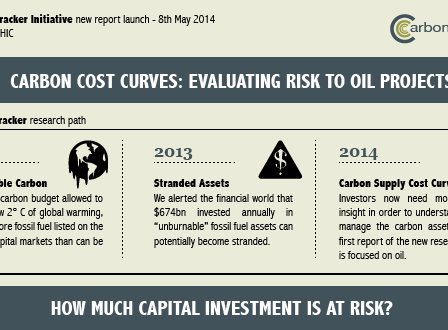Many investors’ portfolios are still weighted towards enterprises that rely on the use of fossil fuels. What if these investments turn out to be grossly overvalued, or if fund investments are heavily tilted towards such ventures? According to research by the British-based Carbon Tracker Initiative (CTI), this could lead to hard-hitting economic imbalances. The British government, the Bank of England, Lloyd’s, HSBC, Citigroup and many other players have already begun to react to CTI’s research results, by further diversifying their assets.
Being profitable on the financial markets involves risk management, foresight and taking a position. Various risk factors are emphasised in a number of ways within each investment fund and between markets. As a rule of thumb, risks should be spread in order to counter the risk of stock market bubbles, for example. However, the financial markets do not always focus on long-term risks. One example is the global carbon risk brought on by climate change. The carbon risk refers to the asymmetry between global warming and the world’s carbon budget, i.e. how much of known fossil fuel reserves we can burn safely. Carbon Tracker Initiative’s reports have finally brought carbon risks to the attention of investors and analysts, in the form of a straightforward set of figures. The issue can finally be discussed in the language of finance.
We have much more information on climate change and its impacts than on issues such as the financial crisis. Despite this, measures taken to combat climate change have been considerably more modest than those applied to resolving the financial crisis. No doubt the complexity of climate change makes the concept difficult to grasp. This is precisely why solutions cannot be found through number crunching alone. Account should also be taken of the diverse ways in which people from different walks of life understand and react to climate change.
How much of our fossil fuel reserves can we burn?
“According to the International Energy Agency (IEA), if we want to keep global warming below 2°C we can only burn 25% of the world’s total known fossil fuel reserves. According to our calculations, even this figure depends on how big a risk we are prepared to take. In a scenario where the risk is 80%, only 20% could be burned. But if we want to toss a coin and base the calculations on a 50% risk, even then we could only burn one third of current reserves at most,” says Carbon Tracker Initiative’s CEO Anthony Hobley.
Would you play the lottery with your investments?
Hobley says that carbon risks are not just about climate change; financial risks are also involved.
“According to our most recent research, many oil-related projects are based on the gamble that oil prices will remain high. In principle, this is fine as long as investors are aware that their money is going to companies that are building their future on such expectations. Bearing this in mind, our goal has been to provide investors with a tool for increasing the transparency of these investment risk factors,” Hobley explains.
Against this background, it is somewhat absurd that oil companies and others with investments tied to fossil fuels are choosing to downplay the issue. If no risks are looming on the horizon, why do the same people keep insisting that coal is a fuel of the past?
“Whether people want to believe it or not, we are in the middle of a transition. We could reduce the impact of this in a controlled manner, but it remains to be seen whether humankind has what it takes, or will we get ourselves into a position where we have to push the panic button?” asks Hobley.
Four recommendations for investors on carbon risks
Hobley’s message to Finnish investors was clear: be sure to assess your portfolio’s exposure to carbon risks. What is the probability that the world’s decision-makers will actually start taking action to mitigate climate change – is it 0%, 100%, or something between the two? It would also be worth assessing the potential risks associated with portfolios from this angle.
Anthony Hobley gives investors four recommendations on the management of carbon risks.
- Check your portfolio and identify any companies with links to fossil fuels.
- Find out if most of the capital expenditure of such companies is associated with high-cost projects.
- Investigate the position of these companies on carbon risks, their risk-management schemes and their preparedness to handle risks if they are realised.
- Ask the right questions; as an investor, you need to be able to form a comprehensive picture of the size of the carbon risks and the financial risk in order to evaluate your portfolio’s risk exposure.
Carbon Tracker Initiative will publish new reports on the world’s carbon and gas reserves in the autumn of 2014. It completed its most recent report on the risks associated with investments that are heavily reliant on oil reserves on 8 May 2014. On that same day, the journalism crowdfunding service Rapport began to seek funding for a corresponding study in Finland. Hopefully, it will be successful and Finnish investors will be provided with new tools for assessing the risk exposure of their portfolios.
Related material:
- An interview with Anthony Hobley on video
- Anthony Hobley’s presentation on Carbon Risks for Investors
- Carbon Tracker Initiative reports
- New York Times Weighing the Risks of Investing in Energy Companies
- Financial Times Oil groups warned over spending on high-cost areas (only for subscribers)
- Articles in The Guardian:
Carbon bubble will plunge the world into another financial crisis – report
Carbon Tracker has changed the financial language of climate change - EduBirdie (updated on 16 December 2022, previously published on Rolling Stone magazine): Global warming’s terrifying math by Bill McKibben




Recommended